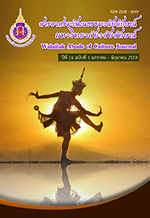โนรา: การอนุรักษ์และพัฒนา
Main Article Content
Abstract
บทความนี้นำเสนอสาระสำคัญ 3 ประการ คือภาพลักษณ์ของโนรา ความคิดในการพัฒนาโนรา และลู่ทางการอนุรักษ์ ด้านภาพลักษณ์ของโนราชี้ให้เห็นว่า โนราเป็นวัฒนธรรมการแสดงของชาวภาคใต้ที่ผู้แสดงสื่อสารด้วยการเคลื่อนไหวของร่างกายอย่างมีจังหวะซึ่งสัมพันธ์กับความคิดและจิตวิญญาณ โนรามีต้นกำเนิดหรือรากเหง้า มีการทำหน้าที่และมีกระบวนการรักษาค้ำจุน กระบวนการรักษาค้ำจุนโนรา คือกระบวนการผลิตซ้ำที่ใช้การผสมผสานและปรับเปลี่ยน ด้านความคิดในการพัฒนาโนราเน้นการดำรงอยู่ในปัจจุบันและอนาคตโดยที่ไม่สูญเสียเอกลักษณ์เดิมมากนัก การเปลี่ยนแปลงควรเป็นไปอย่างค่อยเป็นค่อยไป ด้วยการประสานความคิดอย่างลงตัวระหว่างศิลปิน ผู้เสพย์ และผู้แสวงหาประโยชน์ไม่ใช่เปลี่ยนแปลงเพื่อความแปลกใหม่หรือเพื่อความจำเป็นทางเศรษฐกิจ ควรเน้นการคงรูปแบบเดิม โดยเปลี่ยนแปลงเพียงบางส่วน ขณะเดียวกันต้องให้ความสำคัญในการแลกเปลี่ยนกับวัฒนธรรมใหม่ ส่วนลู่ทางการอนุรักษ์ควรเน้นการศึกษาวิจัยให้ได้ข้อมูลระดับลึกเกี่ยวกับองค์ความรู้โนราในทุกด้าน และนำผลการศึกษาวิจัยมาปรับใช้ ในการอนุรักษ์โดยยอมรับการปรับเปลี่ยนรูปแบบ การสร้างรูปแบบใหม่ รวมทั้งใช้เทคนิคและลีลาการเคลื่อนไหวแบบใหม่เข้าไปด้วย
Nora: Conservation and Development
This article demonstrates 3 main points: image of Nora, Nora development concepts, and means of conservation. First, for the image of Nora aspect, it indicates that Nora is a performance culture belongs to Thailand’s southern people of which the performers communicate with the audience by using rhythmic body movements. Nora relates to people’s mind and spirit and has an origin or root. It also carries functions as well as maintenance process. Nora maintenance process is a repetitive production process which requires integration and adaptation. Secondly, in terms of Nora development concepts, it is aimed at its existence in the present as well as the future without sacrificing too much its original uniqueness. The change should proceed gradually by the harmonious collaboration of concepts and suggestions among artists,audiences, and benefit seekers. The change should not be conducted for novelty or economic necessity but rather be focused in maintaining the original pattern and alter only some parts. At the same time, the importance should also be paid to exchanging ideas with new cultures. Thirdly and lastly, as for the conservation means, the emphasis should be given to conducting researches in order to obtain insight data regarding every aspect of Nora knowledge. The research findings should then be utilized for conservation in accordance with acceptance of the pattern change, patter reformation, as well as adopting new movement techniques and styles.
Article Details

This work is licensed under a Creative Commons Attribution-NonCommercial-NoDerivatives 4.0 International License.
© 2018 by Asian Journal of Arts and Culture, Walailak University. All rights reserved.


